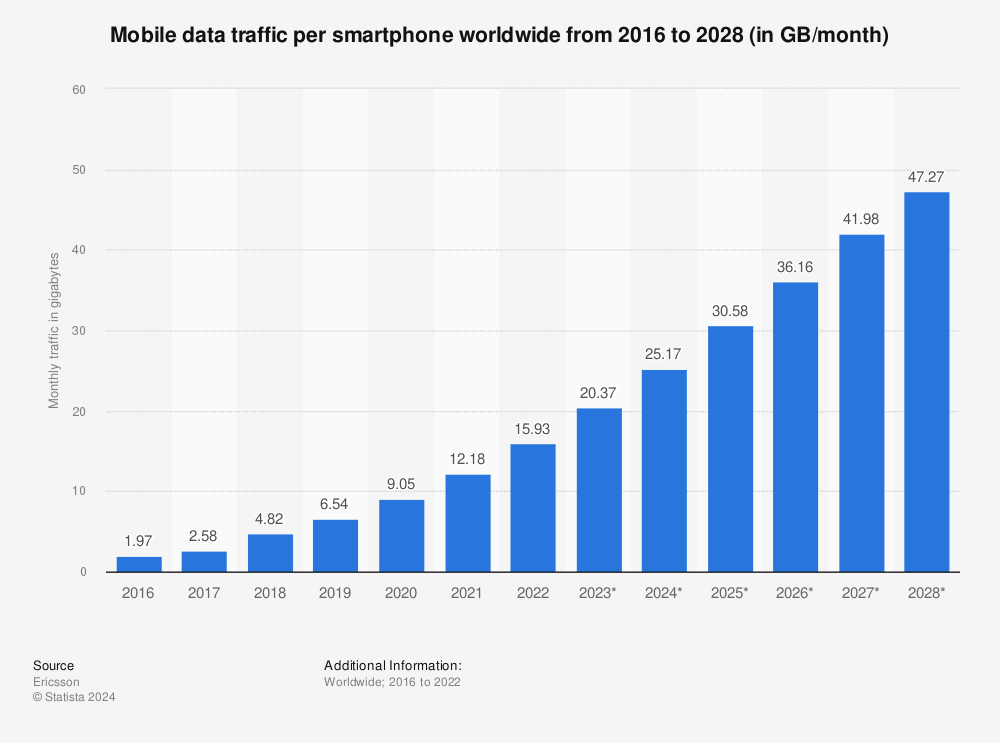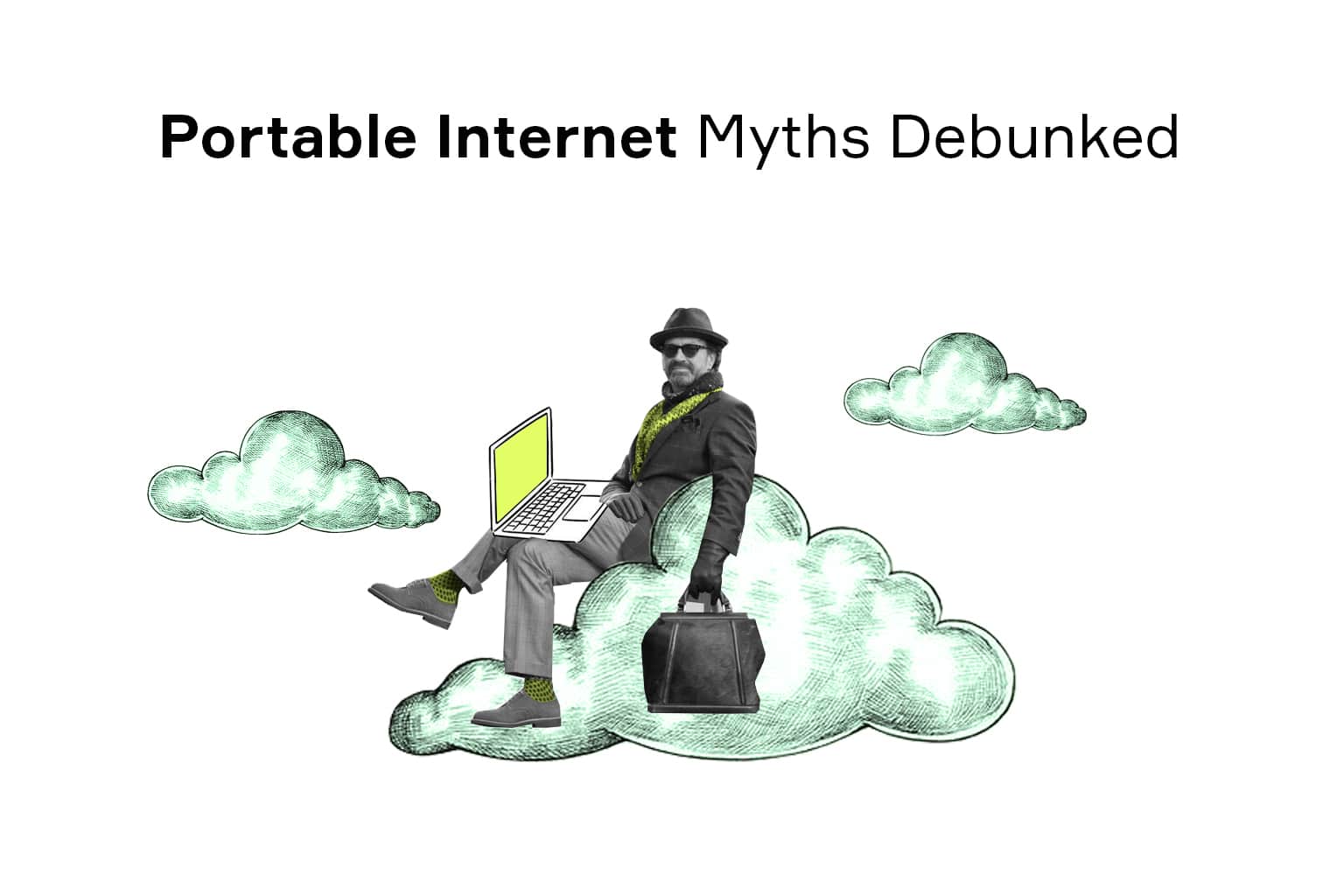
Here’s an exercise for you: ask ten people you know “How much mobile data is enough for a month?” Even if people just name their current data plan, you’ll still end up with a pretty diverse range of responses.
This is hardly surprising – people use their mobile connection for different tasks that require different amounts of data. Even without all the differences introduced by data providers worldwide, choosing a wireless 4G Internet plan will feel overwhelming. Fortunately, there’s nothing particularly tricky about it – you just need to know what to look for. Here’s a primer compiled by our team to help you arrive at the optimal decision.
Data Usage 101
Before we delve into detailed comparisons, it would be nice to cover the basics of data usage by answering the common questions.
How Much Data Does the Average Person Use Per Month?
The average monthly data traffic per phone was around 7 GB in 2019 and continues to climb. However, this number should be taken with a grain of salt.
First, this is the average number, which means it might hold true for some people but will be way off for others. Obviously, an LTE data plan used for daily video streaming will burn through much more data than the one for sending and reading emails.
Second, there is no definitive way to measure data usage, which is why different reports come up with very different numbers. For instance, the 2019 Communications Market Report from the UK presents a much lower figure of 2.9 GB for the same year. At any rate, a single-digit GB value is probably in the right ballpark.
How Long Does It Take to Use 1GB of Data?
Anywhere from 30 minutes for data-heavy activities like HD video streaming to 30 hours for voice calls. If you want to get really technical, a typical 4G LTE data plan nowadays offers a download connection speed of around 30 to 45 Mbps, although the fastest LTE modem may peak as high as 150Mbps. Theoretically, at this speed, one gigabyte will be gone in less than an hour.
On the other hand, less data-intensive tasks like instant messaging and data synching for Google suite can work on the same volume for weeks. Still, other activities, like using social networks and browsing the web, will have wildly varying results depending on what content you may stumble upon in the process.
How Many GB of Internet Do I Need per Month?
Anywhere from 1 GB to 10 GB depending on your needs and preferences. As you probably figured out by now, there is simply no one-fits-all answer to this question. A no-contract business Internet user may be perfectly satisfied with a modest 1 gigabyte to send plain emails and manage corporate accounts.
A mobile hotspot data plan for a smart home, on the other hand, would need at least 10GB to ensure good performance for all connected devices. In other words, to answer this question, you would need to start by deciding what you want your 4G mobile USB modem for.
How Much Data Do I Need Per Month: The Rundown
As you can see, the answer to “Which data plan do I need?” is disappointingly vague. Even within a certain category, like the best data plan for international travel, the experience (and the amount of data used) will differ considerably. So, to give you a sense of what you might expect and get you on the right track, here are several concrete examples.
How Much Is 1 GB of Data?
The basic package for going online, 1 gigabyte would give you roughly:
- 30 minutes of watching high definition video;
- 30 hours of web browsing, or up to 4 hours of voice calls.
Nowadays, 1 GB is the most common minimal offering from most mobile internet providers, although you might still find smaller ones intended for text-based communication. To be fair, 1000 MB still allows for a ridiculous amount of email and instant messages through WhatsApp or Telegram – as long as there are no large files attached. All in all, a good option for travel or for modest mobile use in combination with a home WiFi.
How Much Is 3 GB of Data?
A well-rounded data plan that will cover most of the basic needs:
- about 1.5 hours of HD video streaming services;
- over 10 hours of Skype calls, or around 120 hours of web browsing.
For a home user, 3 GB is probably enough for a single device and more than enough to power the entire fleet of IoT devices. The same goes for travel – a couple of episodes of your favorite series plus at least an hour of leisurely browsing is more than enough for an average on-the-road situation. Still, one should be cautious not to download large files, as it will eat up the entire monthly allowance in hours.
How Much Is 5 GB of Data?
Five gigabytes is a solid middle ground between a tight budget choice and comfortable unrestricted use, offering:
- over 20 hours of voice calls;
- more than 2 hours of HD video, or more than 200 hours of web surfing.
5 GB also allows for a ridiculous amount of text messages and emails – somewhere around 170,000 messages without attachments. Of course, it might still feel restrictive for regular use at home, where a single download will consume the entire allowance. Nevertheless, it is enough for comfortable personal and business mobile use as well as for international travel.
How Much Is 300 MB of Data?
With 300 megabytes, you get approximately 10 hours of web browsing or around 10 minutes of HD video. This is clearly not enough as a monthly allowance for any kind of meaningful online experience. However, as a daily amount, it would actually suffice as a data plan for international travel. Also note than 300 MB will send more than 10,000 emails, which is far more than one person can reasonably process in one day. So, while this option falls short for entertainment purposes, it will suffice for business and travel use.
How Much Is 1 TB of Data?
Just to give you a sense of scale, 1 terabyte is 1000 gigabytes, and will yield over 400 hours of high-quality video or something like 30,000 hours of browsing. Simply put, it’s like getting 30 one-gigabyte data plans per day which, for all intents and purposes, is a ridiculous amount. Even using it on traffic-intense tasks like video streaming will require you to spend all day watching, and exhausting the allowance through the heaviest web browsing would require way more hours than there are in a day.
The boldest predictions put the average monthly use by 2025 at around 25 GB, which is why you probably won’t see 1 TB data plans offered by anyone in the foreseeable future.
How to Choose the Right Data Plan?

Finally, now that you understand what to expect from different data plans, let’s look at how you might choose the one suitable for you.
Set Your Priorities
To make the right choice, you need to decide what you actually want the data plan for. As was discussed above, watching TV shows in high definition can eat up data in no time, whereas the amount of business emails you can send is virtually unlimited. Start by asking yourself: Do I need my mobile internet for work or entertainment? A word of warning, though – don’t be dissuaded by terms. There is no international standard for “travel data plan” or “business use,” so mind the activities you intend to perform.
Check Your Device
There’s nothing more aggravating than buying the best data plan only to be capped by your 4G LTE USB modem’s max throughput. This is not an issue for modern hardware which uses the capabilities of 4G to the fullest. For instance, nect MODEM has an average connection speed of 33 Mbps with peaks of up to 150Mbps – essentially all you can reasonably expect from current-gen hardware. Be sure to check the specs of your device – it well may turn out that it doesn’t support 4G at all, which defeats the purpose of paying for larger data plans in the first place (and, in this day and age, is probably a good reason to start looking for a replacement).
Calculate Data Usage
If the general idea of your daily activities is not specific enough for you, you can go a step further and measure your monthly use via tools. There are a variety of tools that explain how to calculate data usage, ranging from a data usage calculator to trackers that track activities on your phone and provide excellent statistics. These will not only help you make an informed decision but can offer insights on suspicious behavior by some apps you’ll want to know about.
The Best Data Plan: Final Thoughts
 As with any reasonably complex topic, as you delve into the intricacies of data plans, it becomes evident that a clear-cut answer is simply not possible. For some people, especially those who rely on the Internet for business, connection speed and reliability is what matters the most, while the data usage itself is relatively modest. Others prefer binge-watching their favorite show while on the move, in which case a high-volume allowance is a must.
As with any reasonably complex topic, as you delve into the intricacies of data plans, it becomes evident that a clear-cut answer is simply not possible. For some people, especially those who rely on the Internet for business, connection speed and reliability is what matters the most, while the data usage itself is relatively modest. Others prefer binge-watching their favorite show while on the move, in which case a high-volume allowance is a must.
Finally, there are professionals who regularly send large volumes of data over a 4G mobile USB modem, which typically demands the best from both worlds. To cover all the bases, nect MODEM comes with a selection of local, regional, and global options to make it a truly international solution.
All illustrations are created by Lucy Ivanova, a Chief Creative Officer at nect.




